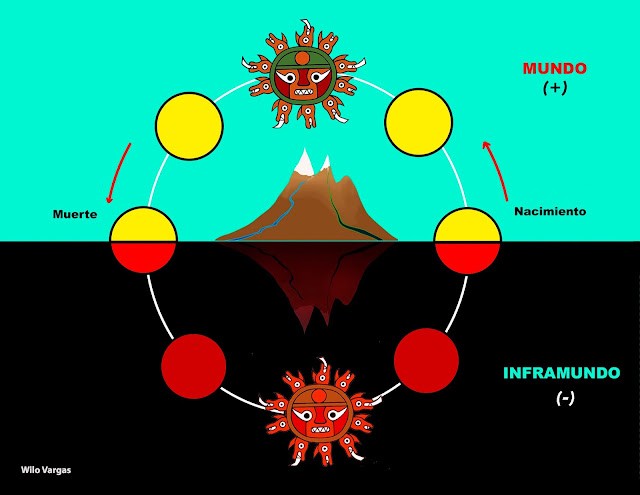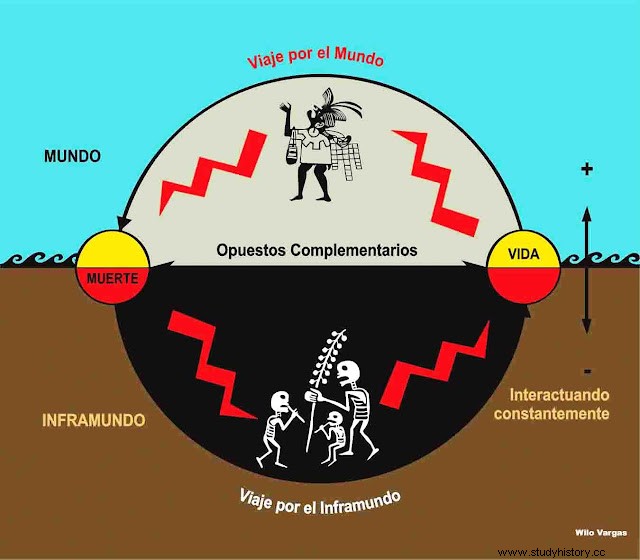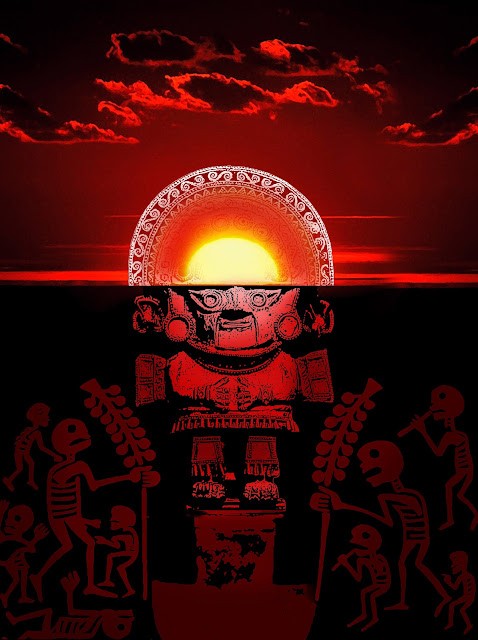NAYLAMP? In the 17th century, campaigns to extirpate idolatry began in the viceroyalty of Peru with the intention of achieving greater progress in the evangelizing company of the Hispanic colonies. During these crusades thousands of people were tortured and sentenced. A large number of mummies, paraphernalia and Andean representations (called "idols" by the extirpators) were destroyed and incinerated. In the year 1610, the Cuzco priest Francisco de Ávila was appointed the first judge to extirpate idolatry by the archbishopric of Lima, and to get an idea of the magnitude of his work, Ávila specified that in his first years of service he destroyed more than 18,000 idols. mobile and 2,000 stationary idols. It should be noted that there was no contemplation for any thought other than the Christian, all the images or representations of nature made by the Andean man were considered idols or satanic gods, and therefore, their destruction was justified. They were definitely times when the construction of the colonial ecclesiastical system was tortuous.


These events were recorded in the history of Peru, but today it could be said that there are serious intentions for analyze and study the Andean prodigy; however, it is still necessary to overcome the lightness of continuing to increase the Andean pantheon. There is abundant literature in which the owl, octopus, condor, feline, lizard, spider and other animals are mentioned as gods, that is to say that many images of nature, represented by the Andean man, were labeled as a god or deity . It is conventionally accepted that a pre-Hispanic image is given this category, since the collective unconscious is predisposed not to refute it and this happens perhaps as a result of the cultural heritage of the era of idolatry extirpation. This deserves to ask:Is it the right thing? Were there so many pre-Hispanic gods? We can categorically answer that it is false. There were not as many gods as the thousands of images represented in Andean iconography. We should not underestimate pre-Hispanic societies and label them as groups with such basic belief systems and totally polytheistic thoughts.

Illimo's knife, better known as the "Golden Tumi" of the Lambayeque culture, It is still known as the representation of a deity or a god of great importance, so much so that for some researchers this knife would represent the mythical character of Naylamp, the god of water or the pre-Hispanic mythical bird. The abundance in terms of classical representation, stylized in the slanted eyes (winged and/or almond-shaped) as a central theme in masks, wall paintings, textiles or ceramics make this icon a supposed deity of great importance. The main and only argument that supports that the Tumi or knife of Illimo represents Naylamp is precisely the well-known myth of Naylamp, which for some scholars is a legend and for others it is a narrative. It was registered by two Dominican priests:Don Miguel Cabello de Balboa in 1586, which is the most extensive, and the other in 1782 by Modesto Rubiños y Andrade. The narrative is summarized in the arrival, by sea, of a foreign character with his retinue to the Lambayeque area where a new dynasty is established and formed (which has not been archaeologically corroborated). When the character dies, he lies to his followers saying that he grew wings and that he disappeared (some authors add their own to the narrative and say that Naylamp flew to heaven). The narrative goes on to mention twelve descendants and the temptation of the devil in the form of a woman towards a principal, with whom he copulates and suffers divine punishment when a 30-day flood comes upon him. If we analyze this narration we could easily notice its contamination with Judeo-Christian elements, with which we do not intend to detract from said story, it is simply appropriate that the reader has a more objective and critical vision of the Naylamp myth or narration.Associating a mythical character to evidence Archaeological research is not an easy task and even more so considering that myths disassociate reality from historical facts, and undoubtedly the objective interpretation of cultural material is distorted. However, some researchers applying the comparative method have found elements that would associate the Naylamp myth with the Tumi or knife of Illimo and take as their main argument, the stylization of the eyes (in the form of bird wings), and as Rubiños Andrade recorded that the name Namla would mean "bird or water hen" there seems to be a certain logical relationship; In addition, the Tumi has a slightly aquiline nose and has two supposed lateral wings, which if these trapezoidal protuberances are diligently observed, do not have the stylistic achievement that if they have the true wings represented in the iconography and that have feathers. If the Lambayecan artist avoided putting feathers on it, it is because there was no intention or premeditation to interpret wings.


In order to objectively interpret this icon (Tumi) it has to be observed as a structure Andean philosophy (Pacha Yachay), which consists of elements that are related and interact with each other. So much so that if we separate them and analyze them individually, we will notice that there is coherence and justification for why the artist made a selection and stylization of each element. The set or structure of all these elements would lead to philosophical concepts of life and death, which are complementary opposites and are united by the peculiar journey in the darkness of the underworld. It is a philosophical conception of its own and quite elaborated, as a result of a long evolutionary process of Andean thought that was qualified from formative times. In the Andean cosmovision, it is considered that man, the earth, the spirits and all natural phenomena are a unit or a "whole" that are perpetually related, maintaining a symbiosis and balance, just like a living being.

According to the proposed reflection, El Tumi represents a marine landscape, where the Sun plays a leading role when he is represented at the moment he enters the underworld at sunset (considering that the sea is the main door to the underworld). The anthropomorphic form is the representation of the man who imitates or follows the sun in that magical descent. The character requires everything essential for his movement and is dressed with supernatural attributes that will allow him a better development on that trip:a mask that will give him the ability to see in the dark, earrings with images of seabirds with the ability to enter to the sea and possibly, what has been interpreted as wings would be nothing more than a pair of fins to move in the extensive watery areas of the underworld. For the artist Lambayeque, the justification for placing a knife as a base is probably due to the quality of this instrument of being able to penetrate a body, and it is that when a man dies, he would symbolically be entering the body of the earth or pachamama.

MYTH OF NAIMLAP “...The natives of Lanbayeque say (and with them make up the other towns in this neighboring valley) that in very ancient times, which do not know how to number them, a father of Companies, a man of great value and quality named Naimlap, and with him he brought many concubines, but the main woman was said to be called Ceterni. his officers who were forty, as well as Pita Zofi who was his trumpeter or player of some large snails, which among the Indians they esteem highly, another Ñinacola who was the one who took care of his litter and chair, and another Ñinagintue who was in charge the life of that Lord as a Botiller, another called Fonga sigde who was in charge of spilling seashell powder on the land that his Lord had departed from Pisar, another Occhocalo was his Cook, another was in charge of the uncio nes, and color with which the Lord adorned his face, this called Xam muchec was in charge of bathing Lord Ollop-copoc, he made t-shirts and feather clothes, another principal and highly esteemed of his Prince named Llapchiluli, and with these people ( and other infinite officials and men of account) he brought adorned, and authorized his person and house. This Mr. Naymlap with all his spare parts came to contribute and take land at the mouth of a river (now called Faquisllanga) and, finding their rafts abandoned there, entered the inland, wishing to make a seat there, and having traveled a space of half a league they built some Palaces in their own way, whom they called Chot, and in this house and palaces they summoned with barbaric devotion an Idol that they brought counter-made on the face of their own leader, this one was carved in a green stone, whom they called Yampallec (which means figure and statue of Naymlap). Having lived many years in peace and quiet these people and their Lord, and leader had many children, the time of his death came, and because his vassals did not understand that death had jurisdiction over him, they buried him secretly in the same room where he had lived, and they published throughout the earth, that he (by his very virtue) had taken wings, and had disappeared. His absence was felt so much by those who followed him when he came that even though they already had a large number of children and grandchildren, and were very passionate about the new and fertile land, they abandoned everything, and dispossessed, and without care or guidance left to look for him everywhere, and so at that time there were no more of those born on earth left on earth, which was not a small number because the others spilled out without order in search of the one they believed had disappeared…” I remain with the Ymperio and command of the dead Naymlap, his eldest son Cium, who married a girl named Zolzoloñi:and in this and in other concubines he had twelve sons who each was the father of a copious family, and after This Cium lived and ruled for many years, he got into a dumb underground, and there he let himself die (and all so that his posterity would be considered immortal and diuine). Due to his end and death from this government Escuñain to this heir Mascuy, to this Cuntipallec subceded and after this government Allascunti, and to this Nofan nech subceded to this subceded Mulumuslan after this he had the command callcoll to this subceded Lanipat =cum, and after this seigniory Acunta. It happened to him in Señorio Fempellec, this was the last and most unfortunate of this generation because he set his mind on moving that Guaca or Idolo to another place that we left said after putting Naymlap in Choc's seat, and while trying this attempt he could not come out with him, and right away the Devil appeared to him in the shape and form of a beautiful woman, and such was the deceit of the Devil, and so little the continence of the Femllep, that he slept with her according to what is said, and that he finished perpetuating the town hall It began to rain so badly (something that had never been seen in these plains) and this deluge lasted thirty days, which was followed by a year of great sterility and famine:well, as the priests of their idols (and other principals) were notorious They understood the serious crime committed by their Lord to be the penalty corresponding to his guilt, the one that his People suffered, with rainy famines, and needs:and for taking revenge on him (forgetting the fidelity of vassals) they arrested him and tied his hands. hands, and feet, they threw him into the depths of the sea, and with him they finished the line and descendants of the Lords, natives of the Lambayeque Valley ansi called by that Guaca (or Ydolo) that Naymlap brought with him whom they called Yampallec... ” (Original version by Miguel Cabello de Balboa 1586:927 - 530)
